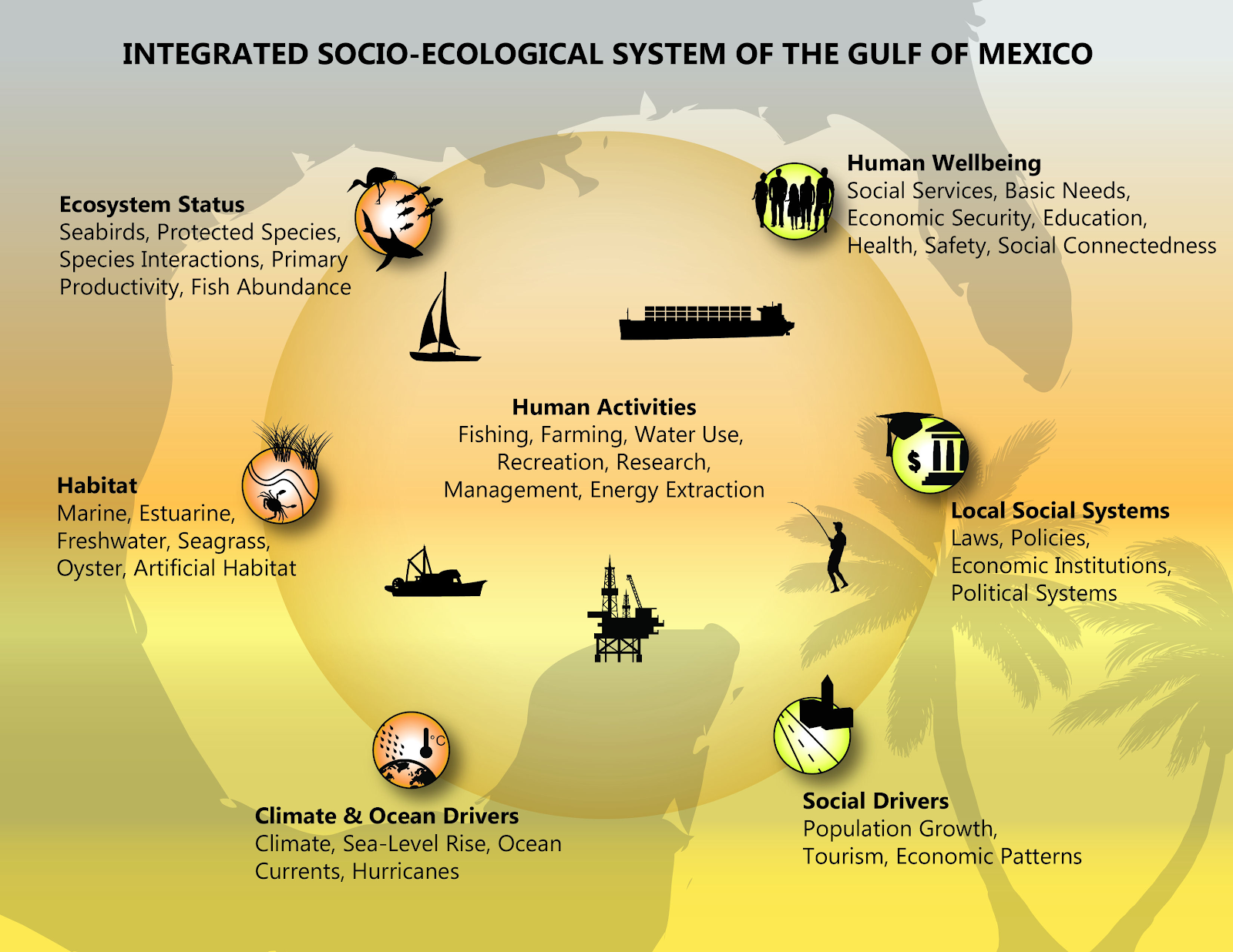In a collaborative effort with researchers, managers and local community members, a team of NOAA scientists are leading the use of the Integrated Ecosystem Assessment approach to balance the needs of nature and society through integrated science for current and future generations of the Gulf of America. The Integrated Ecosystem Assessment (IEA) approach brings ecosystem science and management advice to natural resource managers to effectively carry out ecosystem-based management in the Gulf of America, formerly the Gulf of Mexico. The goal of the Gulf of America IEA is an ecosystem that is sustainable and capable of delivering societally desired levels of ecosystem services.
This project is part of a worldwide movement towards Ecosystem-Based Management (EBM) as the approach to safeguard marine ecosystems and their services. As coastal populations continue to grow the demand for access to these benefits is increasing. In order to sustain ecosystem services, it is important to first understand and protect the environments from which they are derived.
How is the Gulf of America IEA team using the IEA approach to support EBM?
The Gulf of America IEA team is carrying out key steps in the Integrated Ecosystem Assessment (IEA) approach to enhance the likelihood of successful implementation of EBM in the Gulf of America marine ecosystem. Some of these steps include:
- defining the ecosystem and specific ecosystem objectives
- assessing ecosystem status through development and monitoring of indicators
- identifying and prioritizing key sources of risk
- quantitative ecosystem modeling to evaluate the potential of different management strategies to mitigate risk and achieve objectives
IEA is both an incremental approach to decision theory and an iterative process, where scientific understanding feeds an array of management tradeoffs, and balances feedback from changing ecosystem objectives. Furthermore, the IEA framework can be scaled to yield applications and products that meet the complexity or geography of specific EBM objectives (Harvey et al. 2017).
To learn more about how the Gulf of America IEA team is applying the approach to different EBM objectives go to the projects page here.
Defining the Gulf of America Ecosystem
The Gulf of America Integrated Ecosystem Assessment (IEA) team has undertaken several conceptual modeling efforts to elicit subject matter expert opinion and engage stakeholders in conceptualizing the integrated systems of the Gulf of America. The team utilizes a holistic approach for conceptualizing the integrated socio-ecological system in the Gulf of America by incorporating metrics from all areas of the Driver-Pressure-State-Ecosystem Service-Response (EBM-DPSER) framework. Conceptual modeling efforts with the Gulf of America IEA team have included in-person efforts to support group decision-making, web-based platforms that allow for real time collaborative thinking, and computer-based systems that support Fuzzy-logic Cognitive Mapping and allow for the testing of statistical significance of connections in the various systems and subsystems. These efforts have resulted in a series of conceptual models pertaining to various sectors of the ecosystem and the connections to human processes. One overarching result from this work is the integrated Socioecological conceptual framework used to guide indicator development for the Gulf of America. Important to the framing of the Gulf of America Socioecological conceptual framework are the links between humans, the coastal environments, and the species that inhabit these places.

Gulf of America Ecosystem management objectives
Despite the many ecological services provided by the Gulf of America Large Marine Ecosystem (LME) management of the system historically has been done on a case by case or single species basis so there is a need for further integration and ecosystem considerations to properly manage this complex socio-ecological system. The Gulf of America IEA program is supporting several different management efforts.
The Gulf of America IEA is providing ecosystem science to NOAA's Office of Habitat Conservation, the Coastal Protection and Restoration Authority, and the Louisiana Trustee Implementation Group to inform their decision-making concerning the Mid-Barataria Sediment Diversion Project.
The Gulf of America IEA also continues to provide the Gulf of Mexico Fisheries Management Council an Ecosystem Status Report which supports the stock assessments and informs their decisions.
The Gulf of America IEA has started to work with resource managers within the Florida Keys National Marine Sanctuary. These resource managers are all supportive of using the IEA framework to help transfer scientific information to management to work towards ecosystem-based management.
Assessing Gulf of America ecosystem status through development and monitoring of indicators
Every year the Gulf of America IEA team assembles key ecosystem indicators to assess the status of the ecosystem.
To see the Ecosystem Status Report go here.
Identifying and prioritizing key sources of risk in the Gulf of America
The Gulf of America IEA team is working to identify and prioritize many different risks in the Gulf of America.
To see an example of this go here.
Evaluate the potential of different management strategies to mitigate risk and achieve objectives
The Gulf of America IEA team investigates the tradeoffs among and between ecosystem services and sustainability using cross-sectoral analyses. Through the development of qualitative, semi-quantitative, and dynamic holistic ecosystem models and methodologies, the Gulf of America IEA team helps to inform management decisions and aim to minimize the risk to ecosystem services and sustainability.

